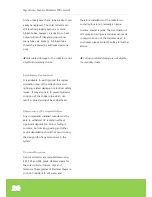
41
Flat Roof
Installation
The high angle frame is adjustable and
appropriate for installations on flat surfaces
and provides adjustment from 27°-57
°
. The
high angle frame kit combines with the
standard frame components to form the
complete frame assembly.
The high angle frame is supplied with Round
Feet that
are also suitable for attachment to
concrete ballast on a flat roof.
For additional strength and support a rear X-
Brace is supplied. The X-Brace has a series of
elongated holes to allow adjustment of the
location of the legs. If further adjustment is
needed, additional
∅
9 mm holes may be
drilled using a good quality drill bit.
Assembly of the Support Frame
When undertaking an installation that
requires an adjustable angle roof frame kit
(such as on a flat roof or a low pitched roof)
it is recommended that the frame is
completely assembled on the ground on a
clear flat area. The collector frames are
relatively light and can easily be carried onto
the roof once assembled. Assembling on the
roof is both dangerous and makes it easy to
lose bolts and nuts that may roll away.
Frame Feet Anchoring
Frame feet should be bolted to the
installation surface using 8 mm diameter
stainless steel bolts or a similarly sturdy
fastening method. (Galvanized bolts should
be NOT be used as these can result galvanic
corrosion).
The surface or concrete block must be
strong/heavy enough to withstand load
during high winds. Consult a professional
structural engineer for design requirements.
Adjusting Frame Angle
The rear legs of the high angle frame
comprise two interlocking pieces (top and
bottom leg), which allow the length of the
rear leg to be adjusted, thus changing the
collector angle from between 27
o
and 57
o
.
The rear legs must never be positioned
greater than a 90
o
angle (perpendicular) with
the roof surface, meaning the legs must be
behind the position of the manifold, not in
front. See diagram to below.
















































